Abstract
BACKGROUND: Cervical intraepithelial neoplasia (CIN) and cervical cancer have been shown to be strongly associated with infection by human papillomavirus (HPV). However, other factors may be contributory in the progression from normal epithelium to CIN and cervical cancer, since not all women with HPV infection develop disease. Recently, it was demonstrated that there is a high risk for cervical cancer and CIN in women with HLA DQB1 * 03 (RR = 7.1, p < 0.0009) (1). Subsequent reports have been conflicting, due to sample size, genetic heterogeneity and differences in the techniques employed for the detection of HLA DQB1 * 03. MATERIALS AND METHODS: DNA from cervical smears of 178 women with CIN and 420 controls with normal cervical cytology was analyzed by polymerase chain reaction (PCR) with type-specific primers for HPV 16, 18, 31, and 33. The DNA from test and control samples were also analyzed by a novel PCR technique, which mutates the first base of codon 40 (DQ alleles) from T to G to create an artificial restriction site for an enzyme Mlu I that distinguish DQB1 * 03 from other alleles and are confirmed by digestion of amplified DNA with Mlu I. Further analysis of individual DQB1 * 03 alleles was performed using PCR and allele-specific primers. RESULTS: One hundred forty-four (34%) out of 420 controls (all HPV 16, 18, 31, or 33 negative and normal cytology), 37/66 (56%) of CIN I and 72/112 (64%) of CIN III were positive for DQB1 * 03 (trend test, p < 0.001, chi 2 = 37.3). A significant association was observed between DQB1 * 03 and CIN (odds ratio 3.03; 95% CI 2.11-3.45). Of women with CIN, 131/178 (73.5%) had HPV (types 16, 18, 31, or 33) infection. There was a significant association between DQB1 * 03 and presence of HPV (odds ratio 3.43; 95% CI 2.25-5.10). Homozygosity for DQB1 * 03 was more strongly associated with CIN than heterozygosity (odds ratios 4.0 and 2.63, respectively); and for the presence of HPV (odds ratio 4.47; 95% CI 2.58-7.77). HLA DQB1 * 0301 was the most strongly associated allele with CIN and HPV (odds ratios 2.53 and 2.63, respectively). CONCLUSIONS: HLA DQB1 * 03 is associated significantly with CIN and may be permissive for HPV infection. Further analysis of class II HLA typing in CIN is necessary to evaluate this association.
Full text
PDF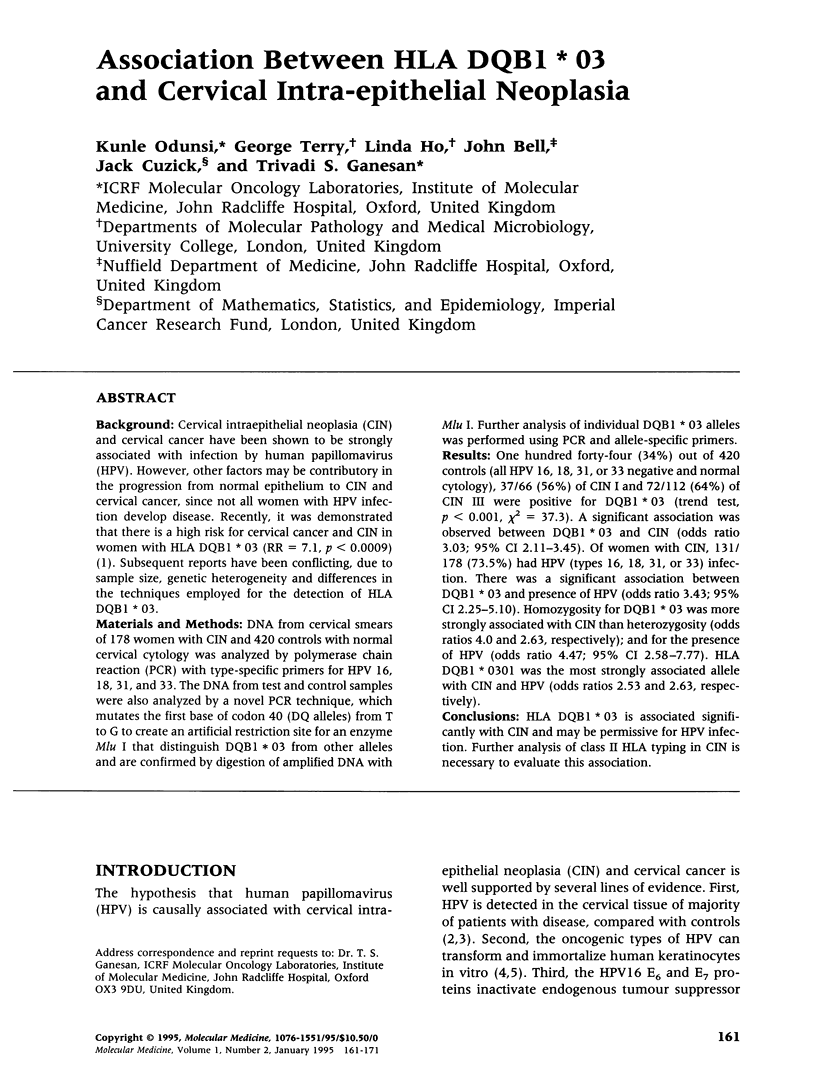
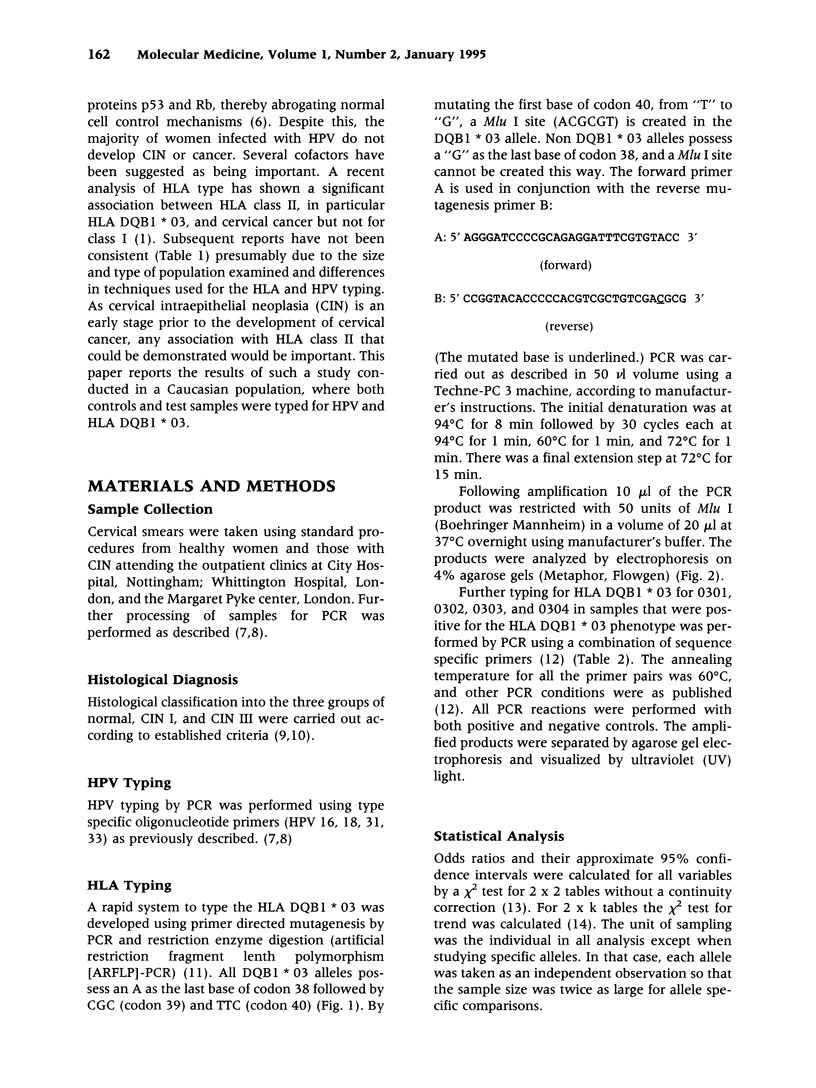
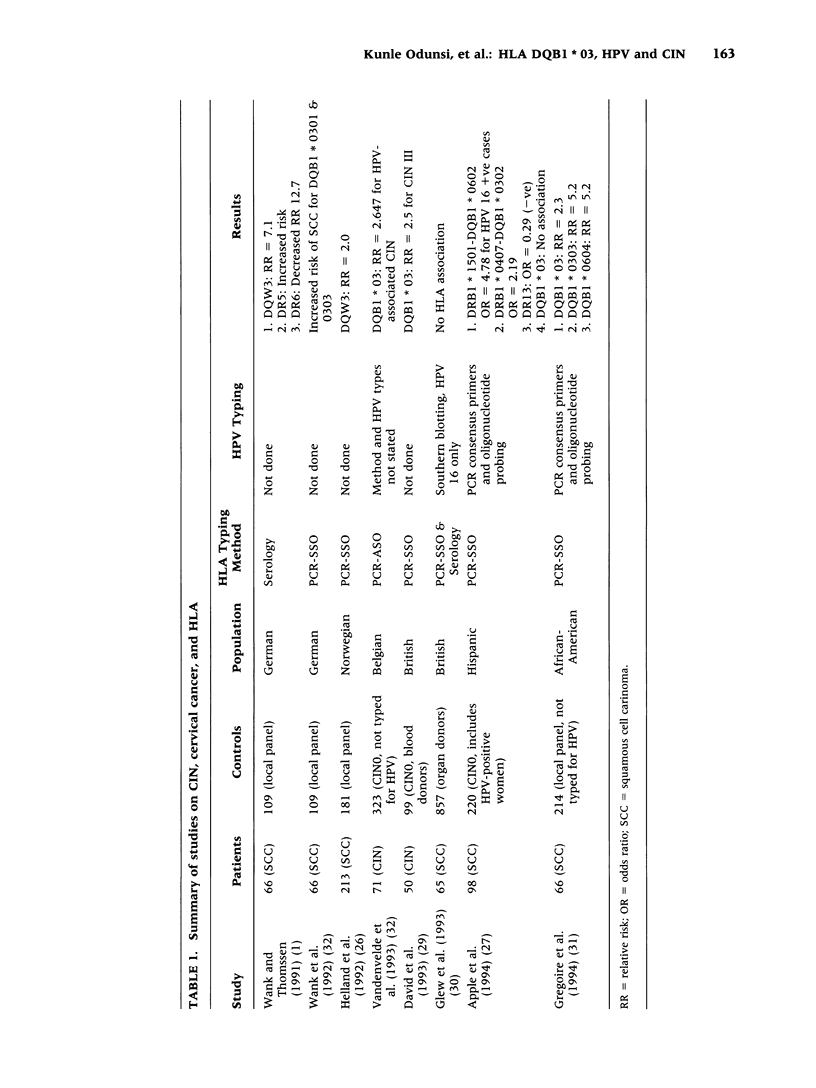
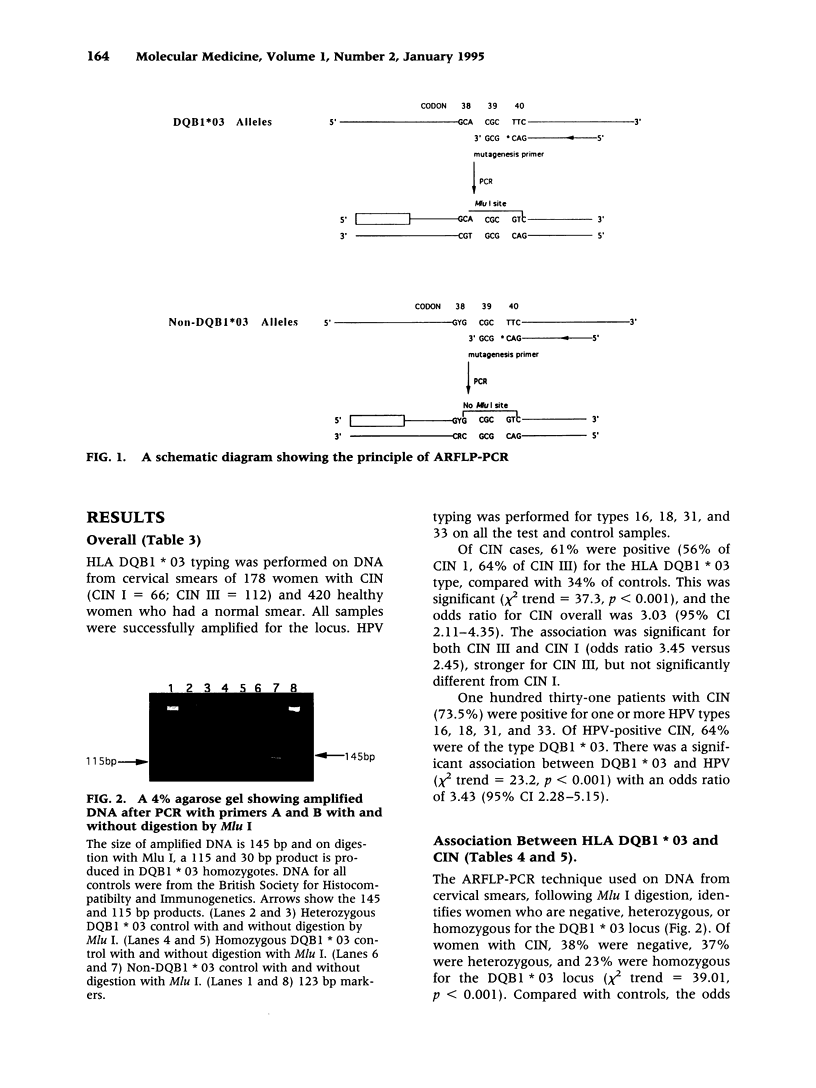
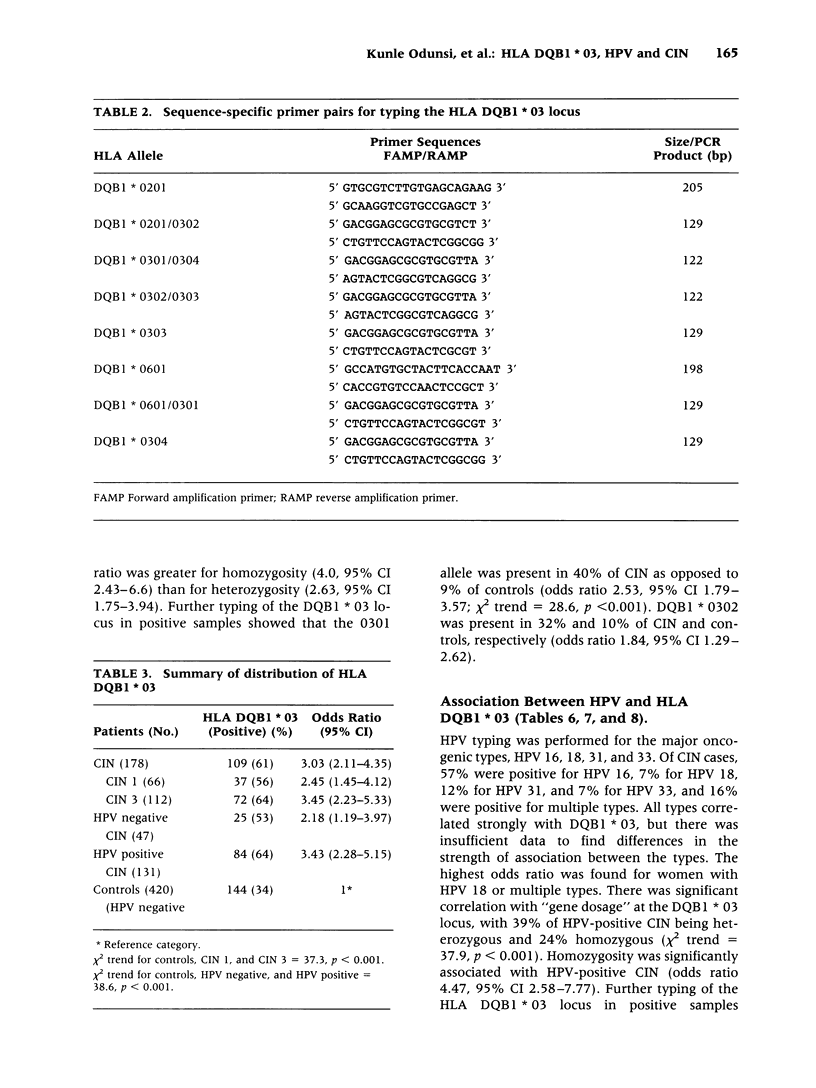
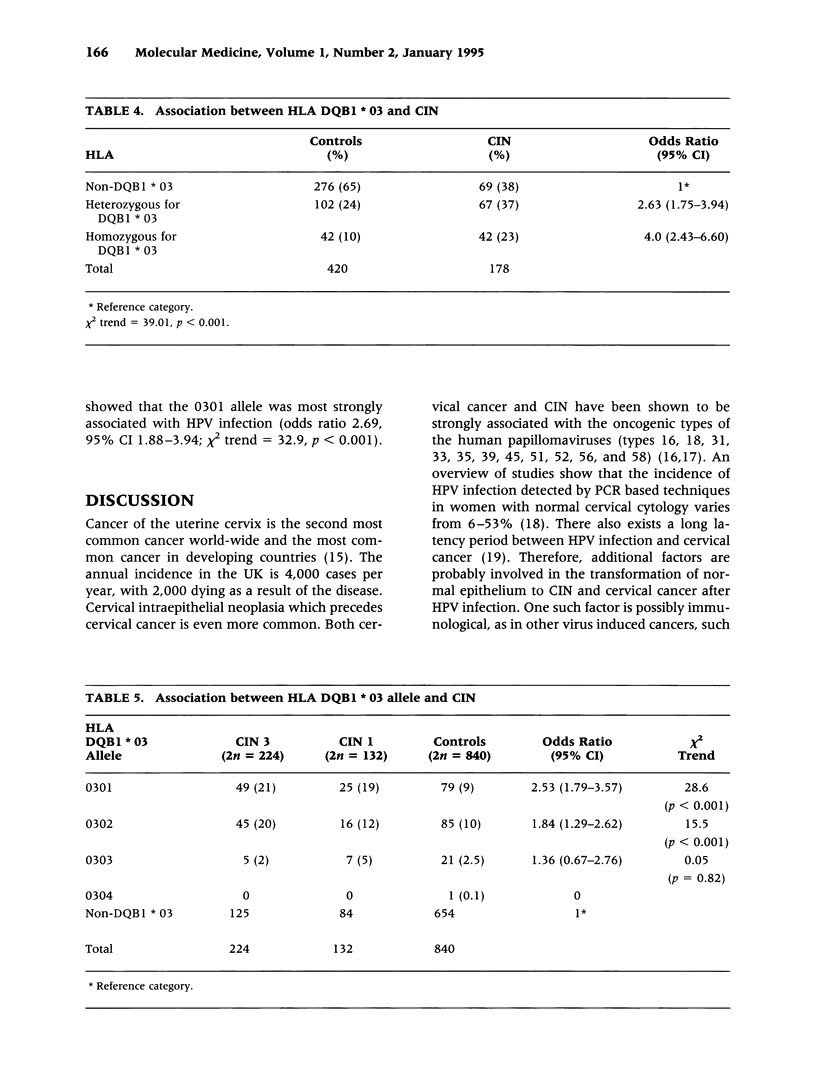
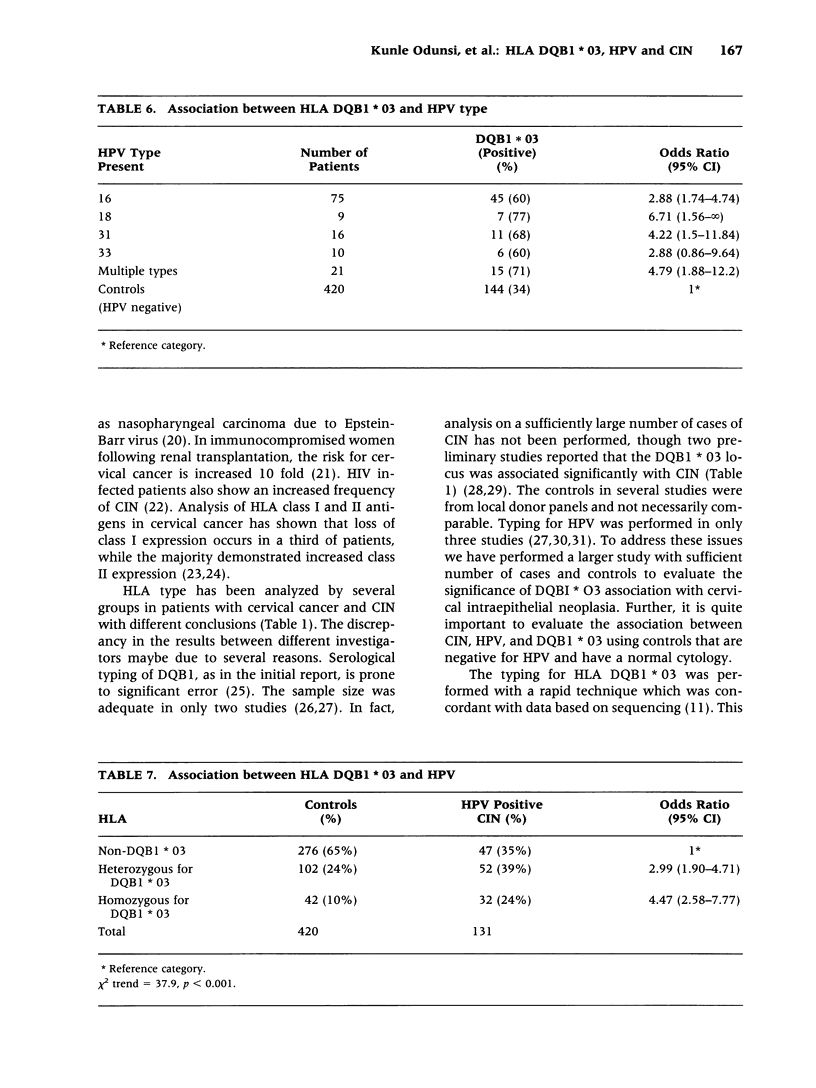
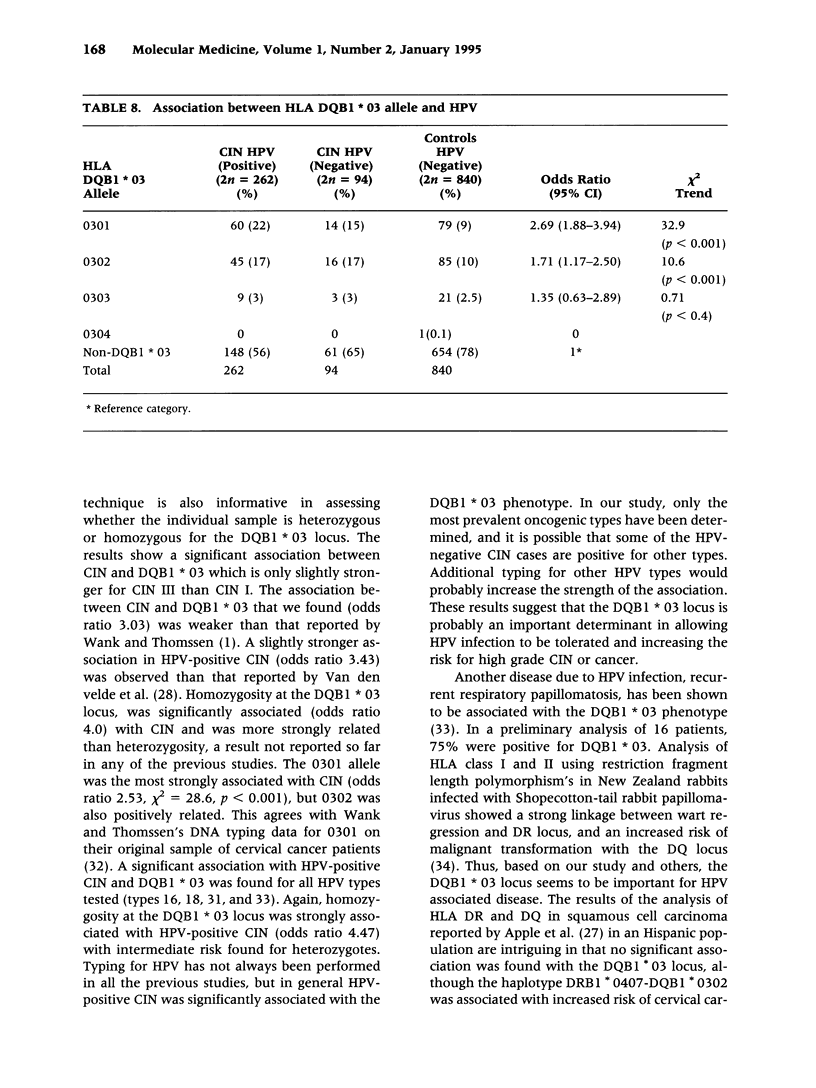
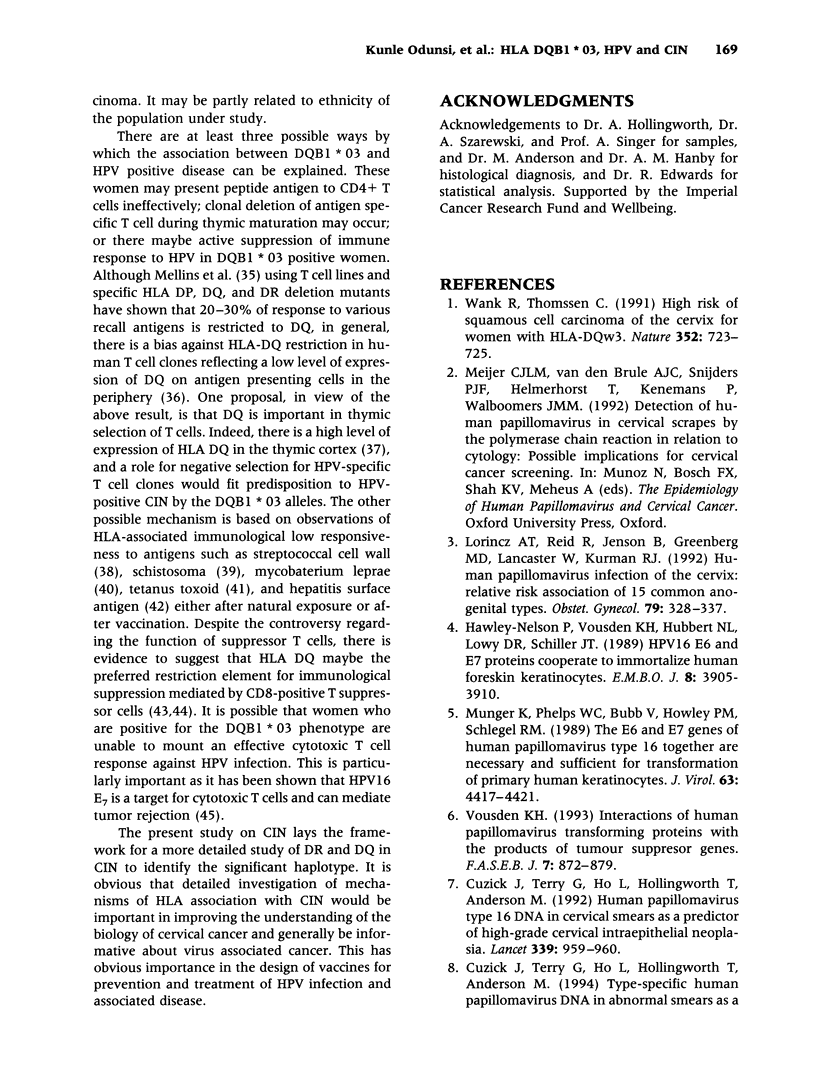
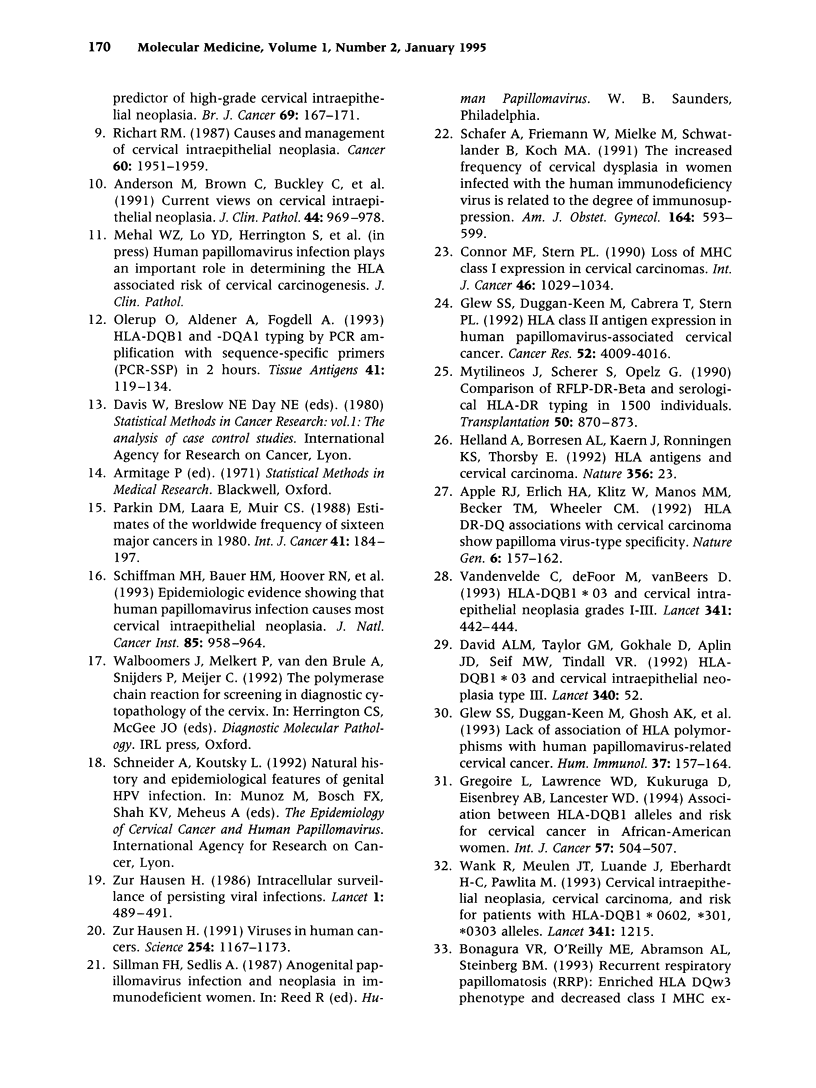

Images in this article
Selected References
These references are in PubMed. This may not be the complete list of references from this article.
- Altmann D. M., Sansom D., Marsh S. G. What is the basis for HLA-DQ associations with autoimmune disease? Immunol Today. 1991 Aug;12(8):267–270. doi: 10.1016/0167-5699(91)90124-C. [DOI] [PubMed] [Google Scholar]
- Anderson M. C., Brown C. L., Buckley C. H., Fox H., Jenkins D., Lowe D. G., Manners B. T., Melcher D. H., Robertson A. J., Wells M. Current views on cervical intraepithelial neoplasia. J Clin Pathol. 1991 Dec;44(12):969–978. doi: 10.1136/jcp.44.12.969. [DOI] [PMC free article] [PubMed] [Google Scholar]
- Apple R. J., Erlich H. A., Klitz W., Manos M. M., Becker T. M., Wheeler C. M. HLA DR-DQ associations with cervical carcinoma show papillomavirus-type specificity. Nat Genet. 1994 Feb;6(2):157–162. doi: 10.1038/ng0294-157. [DOI] [PubMed] [Google Scholar]
- Chen L. P., Thomas E. K., Hu S. L., Hellström I., Hellström K. E. Human papillomavirus type 16 nucleoprotein E7 is a tumor rejection antigen. Proc Natl Acad Sci U S A. 1991 Jan 1;88(1):110–114. doi: 10.1073/pnas.88.1.110. [DOI] [PMC free article] [PubMed] [Google Scholar]
- Connor M. E., Stern P. L. Loss of MHC class-I expression in cervical carcinomas. Int J Cancer. 1990 Dec 15;46(6):1029–1034. doi: 10.1002/ijc.2910460614. [DOI] [PubMed] [Google Scholar]
- Cuzick J., Terry G., Ho L., Hollingworth T., Anderson M. Human papillomavirus type 16 in cervical smears as predictor of high-grade cervical intraepithelial neoplasia [corrected]. Lancet. 1992 Apr 18;339(8799):959–960. doi: 10.1016/0140-6736(92)91532-d. [DOI] [PubMed] [Google Scholar]
- Glew S. S., Duggan-Keen M., Cabrera T., Stern P. L. HLA class II antigen expression in human papillomavirus-associated cervical cancer. Cancer Res. 1992 Jul 15;52(14):4009–4016. [PubMed] [Google Scholar]
- Glew S. S., Duggan-Keen M., Ghosh A. K., Ivinson A., Sinnott P., Davidson J., Dyer P. A., Stern P. L. Lack of association of HLA polymorphisms with human papillomavirus-related cervical cancer. Hum Immunol. 1993 Jul;37(3):157–164. doi: 10.1016/0198-8859(93)90181-y. [DOI] [PubMed] [Google Scholar]
- Gregoire L., Lawrence W. D., Kukuruga D., Eisenbrey A. B., Lancaster W. D. Association between HLA-DQB1 alleles and risk for cervical cancer in African-American women. Int J Cancer. 1994 May 15;57(4):504–507. doi: 10.1002/ijc.2910570411. [DOI] [PubMed] [Google Scholar]
- Han R., Breitburd F., Marche P. N., Orth G. Linkage of regression and malignant conversion of rabbit viral papillomas to MHC class II genes. Nature. 1992 Mar 5;356(6364):66–68. doi: 10.1038/356066a0. [DOI] [PubMed] [Google Scholar]
- Hatae K., Kimura A., Okubo R., Watanabe H., Erlich H. A., Ueda K., Nishimura Y., Sasazuki T. Genetic control of nonresponsiveness to hepatitis B virus vaccine by an extended HLA haplotype. Eur J Immunol. 1992 Jul;22(7):1899–1905. doi: 10.1002/eji.1830220733. [DOI] [PubMed] [Google Scholar]
- Hawley-Nelson P., Vousden K. H., Hubbert N. L., Lowy D. R., Schiller J. T. HPV16 E6 and E7 proteins cooperate to immortalize human foreskin keratinocytes. EMBO J. 1989 Dec 1;8(12):3905–3910. doi: 10.1002/j.1460-2075.1989.tb08570.x. [DOI] [PMC free article] [PubMed] [Google Scholar]
- Ishikura H., Ishikawa N., Aizawa M. Differential expression of HLA-class II antigens in the human thymus. Relative paucity of HLA-DQ antigens in the thymic medulla. Transplantation. 1987 Aug;44(2):314–317. doi: 10.1097/00007890-198708000-00026. [DOI] [PubMed] [Google Scholar]
- Lorincz A. T., Reid R., Jenson A. B., Greenberg M. D., Lancaster W., Kurman R. J. Human papillomavirus infection of the cervix: relative risk associations of 15 common anogenital types. Obstet Gynecol. 1992 Mar;79(3):328–337. doi: 10.1097/00006250-199203000-00002. [DOI] [PubMed] [Google Scholar]
- Mellins E., Woelfel M., Pious D. Importance of HLA-DQ and -DP restriction elements in T-cell responses to soluble antigens: mutational analysis. Hum Immunol. 1987 Mar;18(3):211–223. doi: 10.1016/0198-8859(87)90086-3. [DOI] [PubMed] [Google Scholar]
- Mytilineos J., Scherer S., Opelz G. Comparison of RFLP-DR beta and serological HLA-DR typing in 1500 individuals. Transplantation. 1990 Nov;50(5):870–873. doi: 10.1097/00007890-199011000-00024. [DOI] [PubMed] [Google Scholar]
- Münger K., Phelps W. C., Bubb V., Howley P. M., Schlegel R. The E6 and E7 genes of the human papillomavirus type 16 together are necessary and sufficient for transformation of primary human keratinocytes. J Virol. 1989 Oct;63(10):4417–4421. doi: 10.1128/jvi.63.10.4417-4421.1989. [DOI] [PMC free article] [PubMed] [Google Scholar]
- Olerup O., Aldener A., Fogdell A. HLA-DQB1 and -DQA1 typing by PCR amplification with sequence-specific primers (PCR-SSP) in 2 hours. Tissue Antigens. 1993 Mar;41(3):119–134. doi: 10.1111/j.1399-0039.1993.tb01991.x. [DOI] [PubMed] [Google Scholar]
- Ottenhoff T. H., Walford C., Nishimura Y., Reddy N. B., Sasazuki T. HLA-DQ molecules and the control of Mycobacterium leprae-specific T cell nonresponsiveness in lepromatous leprosy patients. Eur J Immunol. 1990 Oct;20(10):2347–2350. doi: 10.1002/eji.1830201027. [DOI] [PubMed] [Google Scholar]
- Parkin D. M., Lärä E., Muir C. S. Estimates of the worldwide frequency of sixteen major cancers in 1980. Int J Cancer. 1988 Feb 15;41(2):184–197. doi: 10.1002/ijc.2910410205. [DOI] [PubMed] [Google Scholar]
- Richart R. M. Causes and management of cervical intraepithelial neoplasia. Cancer. 1987 Oct 15;60(8 Suppl):1951–1959. doi: 10.1002/1097-0142(19901015)60:8+<1951::aid-cncr2820601505>3.0.co;2-u. [DOI] [PubMed] [Google Scholar]
- Salgame P., Convit J., Bloom B. R. Immunological suppression by human CD8+ T cells is receptor dependent and HLA-DQ restricted. Proc Natl Acad Sci U S A. 1991 Mar 15;88(6):2598–2602. doi: 10.1073/pnas.88.6.2598. [DOI] [PMC free article] [PubMed] [Google Scholar]
- Sasazuki T., Kikuchi I., Hirayama K., Matsushita S., Ohta N., Nishimura Y. HLA-linked immune suppression in humans. Immunol Suppl. 1989;2:21–25. [PubMed] [Google Scholar]
- Sasazuki T., Kohno Y., Iwamoto I., Tanimura M., Naito S. Association between an HLA haplotype and low responsiveness to tetanus toxoid in man. Nature. 1978 Mar 23;272(5651):359–361. doi: 10.1038/272359b0. [DOI] [PubMed] [Google Scholar]
- Schiffman M. H., Bauer H. M., Hoover R. N., Glass A. G., Cadell D. M., Rush B. B., Scott D. R., Sherman M. E., Kurman R. J., Wacholder S. Epidemiologic evidence showing that human papillomavirus infection causes most cervical intraepithelial neoplasia. J Natl Cancer Inst. 1993 Jun 16;85(12):958–964. doi: 10.1093/jnci/85.12.958. [DOI] [PubMed] [Google Scholar]
- Schäfer A., Friedmann W., Mielke M., Schwartländer B., Koch M. A. The increased frequency of cervical dysplasia-neoplasia in women infected with the human immunodeficiency virus is related to the degree of immunosuppression. Am J Obstet Gynecol. 1991 Feb;164(2):593–599. doi: 10.1016/s0002-9378(11)80029-3. [DOI] [PubMed] [Google Scholar]
- Vousden K. Interactions of human papillomavirus transforming proteins with the products of tumor suppressor genes. FASEB J. 1993 Jul;7(10):872–879. doi: 10.1096/fasebj.7.10.8393818. [DOI] [PubMed] [Google Scholar]
- Wank R., Meulen J. T., Luande J., Eberhardt H. C., Pawlita M. Cervical intraepithelial neoplasia, cervical carcinoma, and risk for patients with HLA-DQB1*0602,*301,*0303 alleles. Lancet. 1993 May 8;341(8854):1215–1215. doi: 10.1016/0140-6736(93)91043-l. [DOI] [PubMed] [Google Scholar]
- Wank R., Thomssen C. High risk of squamous cell carcinoma of the cervix for women with HLA-DQw3. Nature. 1991 Aug 22;352(6337):723–725. doi: 10.1038/352723a0. [DOI] [PubMed] [Google Scholar]
- zur Hausen H. Intracellular surveillance of persisting viral infections. Human genital cancer results from deficient cellular control of papillomavirus gene expression. Lancet. 1986 Aug 30;2(8505):489–491. doi: 10.1016/s0140-6736(86)90360-0. [DOI] [PubMed] [Google Scholar]
- zur Hausen H. Viruses in human cancers. Science. 1991 Nov 22;254(5035):1167–1173. doi: 10.1126/science.1659743. [DOI] [PubMed] [Google Scholar]



